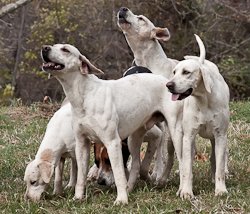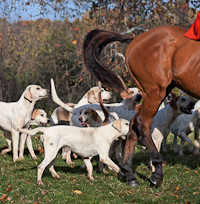Photo Essay: Old Dominion Hounds (November 27, 2010)
Posted by KLM in Landscape, Old Dominion Hounds, Photo Essays, Rappahannock Hunt on December 30, 2010
This photo essay is posted at KLM Images.
Twist & turn
The eye of the viewer can be guided by actual lines in an image, or by implied ones.
These two riders are stacked up on a slanted hillside watching hunting in the lower field. Your eye naturally follows them down starting at the rump of the near horse and then reversing at the lower one. It’s possible the horses are standing still, but the placement of the legs and movement of the tails creates doubt, so you follow the potential movement left and then right, instead of just left along the hillside and out, as you might if the far rider were absent. Read the rest of this entry »
Photo Essay: Rappahannock Hunt (December 11, 2010)
Posted by KLM in Deep Run Hunt, Foxhunts, Landscape, Rappahannock Hunt on December 28, 2010
This photo essay is posted at KLM Images.
Landscapes
I am far from satisfied with my skill at capturing landscapes and am constantly experimenting for better results.
In this essay, I post-processed some of the images for high-dynamic range (HDR) contrast, so let’s look at the results.
Ordinary cameras are more limited in their ability to respond to contrast than the human eye. We see very well in both dim light and blazing sunshine, but for a camera we must choose those conditions in our settings or be disappointed. Depending on the settings, the camera decides to set the exposure to maximize the overall utility of the resulting image, but this reduces the range of absolute darkness and absolute brightness compared to our own vision. The theory behind HDR is to take multiple versions of the same image with different exposure settings, then blend those together so that the overall exposure is much broader than the camera can capture on its own, and closer to what we actually see. Read the rest of this entry »
Photo Essay: Blue Ridge Hunt (November 25, 2010)
Posted by KLM in Blue Ridge Hunt, Foxhunts, Photo Essays on December 26, 2010
This photo essay is posted at KLM Images.
All stacked up
Hounds work well as a concentrated essence since, despite being members of a pack with a common purpose, no two are alike. Here we have two hounds scenting, two ready to roll, and one howling in frustration at standing about. If you could take this in your hand and squeeze it like a sponge, pure “foxhound” would ooze out. Read the rest of this entry »
Photo Essay: Loudoun Hunt West (December 5, 2010)
Posted by KLM in Fairfax Hunt, Foxhunts, Loudoun Hunt West, Photo Essays, Portraits on December 21, 2010
This photo essay is posted at KLM Images.
Cropping for action
I typically come down on the engineering side of the analysis vs artistic spectrum, and this manifests in my photography as wanting to see the whole scene: the entire horse and rider, the full pack of hounds, and so forth. This is an artistic fault, I firmly believe. I know this because, whenever happenstance intervenes and forces a moving target to be cropped in ways I would never have planned, I am often much pleased with the results.
When I stand too close to the action with a particular lens and try to get something useful anyway, the image is reduced to its essentials. I don’t need to see the top of the rider’s head or the details of the horse’s legs to enjoy this shot. Read the rest of this entry »
Photo Essay: Loudoun Hunt West (November 7, 2010)
Posted by KLM in Loudoun Hunt West, Photo Essays on November 24, 2010
This photo essay is posted at KLM Images.
Closeup vs context
We were lucky enough to view three different foxes at this meet. The third resulted in unusable photos but the first produced a long stream of (zoomed in) closeups and the second one, in almost the same spot, produced more distant shots.
Everyone likes a good closeup of a fox, of course. With a big zoom lens you can often capture fox or rabbit shots like these, when you’re lucky and the stars align, and it’s a great day when that happens. But that’s a hunting success (captured!) more than a photographic success; almost any shot of a fox or rabbit during a hunt would qualify as success, regardless of quality.
In the second shot, the fox was much further away and out of very effective reach of my lens. This series of shots aren’t very good fox photos but they are much more interesting hunting photos. Read the rest of this entry »
Photo Essay: Snickersville Hounds (October 31, 2010)
Posted by KLM in Foxhunts, Light, Photo Essays, Snickersville Hounds on November 16, 2010
This photo essay is posted at KLM Images.
Carving up the space
The curved edge of the pond in the first photo eats a nice semicircle out of the left of the scene. That alone would make for a pleasing composition, but see also how the grasses curve with the pond, and so do the bodies and especially the tails of the hounds. Everything reinforces that fundamental curve.

Gothic linear divisions
In the next photo, we have linear architectural elements made up unexpectedly of living creatures.
The accidental formal postures of the hound and the rider, aided by an almost straight horizon, create an inner rectangle and draw the eye into the open space in the back left. Nothing is moving; all is potential. Read the rest of this entry »
Photo Essay: Blue Ridge Hunt (October 30, 2010)
Posted by KLM in Blue Ridge Hunt, Foxhunts, Photo Essays on November 7, 2010
This photo essay is posted at KLM Images.
Arcs
This is not the conventional head pose for this formal pack shot, but I was struck by the lines of horizontal arcs. The eye travels from the rump’s inverted “U” curve to the “U” curve of the coat’s skirt and back to the inverted curve of the horse’s neck. The echo of the coat’s curve with the belly provides stability. The combination conveys balance and permanence.
The horse on the right, by contrast, has vertical arcs, particularly the tail closely echoing the rear. Unlike the shallow stable arcs in the first picture, these are deeper. We know the hind leg will straighten, so we see the deep curve as a spring that will uncoil, driving the horse forward. We also know the matching curve of the tail is impermanent, and that increases the sense of a fleeting second caught and frozen, adding to the sense of motion. Read the rest of this entry »
Photo Essay: Ashland Bassets (October 10, 2010)
Posted by KLM in Ashland Bassets, Hunting with Basset Hounds, Photo Essays on November 1, 2010
The photo essay is posted at KLM Images.
Pack photos
This was the opening meet for the season, so everyone was well dressed for the occasion and the sporting parson was on hand for the blessing of the hounds. This year is also the 50th anniversary of the Ashland Bassets, so it was a day of special celebrations.
You can get hunting action anytime but these dress-up occasions are ideal for pack photos, and on this day the weather and circumstances combined to throw up dozens of pack photo opportunities.
Formal pack shots with staff are useful all year round (for newsletters, calendars, etc.), but the informal ones are not to be scorned. See how the basset with one blue eye peers through the circle set by two other hounds’ tails. Not easy to tell where one hound begins and the next one ends. Read the rest of this entry »
Photo Essay: Blue Ridge Hunt (October 2, 2010)
Posted by KLM in Blue Ridge Hunt, Foxhunts, Light, Photo Essays on October 18, 2010
The photo essay is posted at KLM Images.
Nature vs architecture
The front gates of the Blue Ridge Hunt kennels have two lovely metal fox silhouettes mounted on top. The kennel building is nothing but straight lines, of course: bricks, bars, shingles, and all the other architectural elements, but we get just that bit of nature which gives it personality. Whenever we look at the kennels there are hounds behind the bars (this is their home), but the foxes run free along the top of the gates.
In a more natural context, these two does disturbed by the hunting activity retreat past the barn. The barn is aligned with and echoes the nearby Blue Ridge mountain that ascends behind it, but is dwarfed by it as well.
Though the lighting is attractive on the gable end of the barn, our eyes are drawn to the moving deer. Read the rest of this entry »
Photo Essay: Ashland Bassets (October 3, 2010)
Posted by KLM in Ashland Bassets, Hunting with Basset Hounds, Photo Essays on October 14, 2010
The photo essay is posted at KLM Images.
Hounds at work
The most thrilling shots are those showing the hounds at work, and ideally their prey, too. As the cubbing season draws to a close, that can mean tall autumn grasses and hidden action. But it also means the subtle autumn colors and the last of the flowers.
Basset hounds sometimes seem to understand that they have short legs and seek high ground for advantage.
This particular hound is a photographic favorite of mine. Before I knew her name (Jesse) I was calling her Autofocus because my camera found it so easy to focus on her. Usually a hound is small and lost in a large background scene like this, but her coloring is so vivid as she stands on the Great Meadow course jump that the scene works. Read the rest of this entry »











